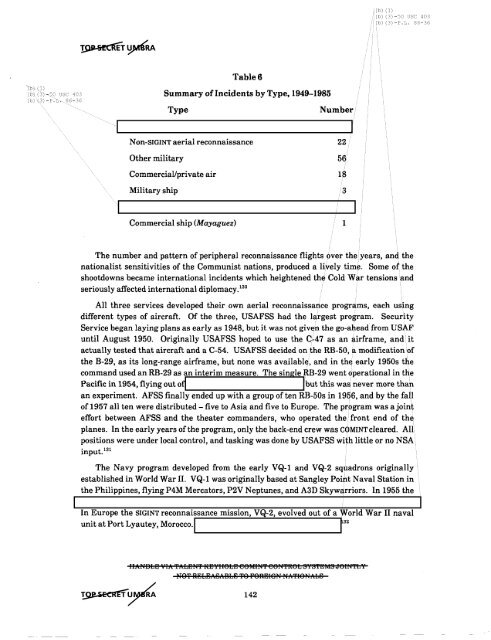American Cryptology during the Cold War - The Black Vault
American Cryptology during the Cold War - The Black Vault
American Cryptology during the Cold War - The Black Vault
You also want an ePaper? Increase the reach of your titles
YUMPU automatically turns print PDFs into web optimized ePapers that Google loves.
'(bl (11<br />
(bl (31 -50 USC 403<br />
(bl (31 -P.L. 86-36<br />
rb}(11<br />
(b) (31~50 USC 403<br />
(b1(31-P .L,.8 6-36<br />
Table 6<br />
Summary ofIncidents by Type, 1949-1985<br />
Type<br />
Number<br />
'--- -----.1<br />
Non-SIGINT aerial reconnaissance<br />
22<br />
O<strong>the</strong>r military<br />
56<br />
Commercial/private air<br />
18<br />
Military ship<br />
3<br />
Commercial ship (Mayaguez)<br />
1<br />
<strong>The</strong> number and pattern of peripheral reconnaissance flights over <strong>the</strong> years, and <strong>the</strong><br />
nationalist sensitivities of <strong>the</strong> Communist nations, produced a lively time. Some of <strong>the</strong><br />
shootdowns became international incidents which heightened <strong>the</strong> <strong>Cold</strong> <strong>War</strong> tensions~nd<br />
seriously affected international diplomacy. 130<br />
All three services developed <strong>the</strong>ir own aerial reconnaissance programs, each using<br />
different types of aircraft. Of <strong>the</strong> three, USAFSS had <strong>the</strong> largest program. Security<br />
Service began laying plans as early as 1948, but it was not given <strong>the</strong> go-aheadfrom USAF<br />
until August 1950. Originally USAFSS hoped to use <strong>the</strong> C-47 as an airframe, and it<br />
actually tested that aircraft and a C-54. USAFSS decided on <strong>the</strong> RB-50, a modification of<br />
<strong>the</strong> B-29, as its long-range airframe, but none was available, and in <strong>the</strong> early 1950s <strong>the</strong><br />
command used an RB-29 as an interim measure. <strong>The</strong> single J:tB-29 went operational in <strong>the</strong><br />
Pacific in 1954, flying out o~<br />
tbut this was never more than<br />
an experiment. AFSS finally ended up with a group often RB-50s in 1956, and by <strong>the</strong> fall<br />
of1957 all ten were distributed - five to Asia and five to Europe. <strong>The</strong> program was a joint<br />
effort between AFSS and <strong>the</strong> <strong>the</strong>ater commanders, who operated <strong>the</strong>. front end of <strong>the</strong><br />
planes. In <strong>the</strong> early years of<strong>the</strong> program, only <strong>the</strong> back-end crew was COMINTcleared. All<br />
positions were under local control, and tasking was done by USAFSS with little or no NSA<br />
input. 131<br />
<strong>The</strong> Navy program developed from <strong>the</strong> early VQ-l and VQ-2 squadrons originally<br />
established in World <strong>War</strong> II. VQ-l was originally based at Sangley Point Naval Station in<br />
<strong>the</strong> Philippines, flying P4M Mercators, P2V Neptunes, and A3D Skywa.rriors. In 1955 <strong>the</strong><br />
In Europe <strong>the</strong> SIGINT reconnaissance mission, VQ-2, evolved out of a World <strong>War</strong> II naval<br />
unit at Port Lyautey, Morocco.I<br />
t32<br />
HltJ1BbEl VIA 'f1tbElU'f ItElYHebEJ eeMIN'f eeU'ffteL S';S'fElMS dem'fLY<br />
~T9'f RjjJb8ASA8U '1'9 F9RlilIOU UA'I'IOUAJ"S<br />
142
















